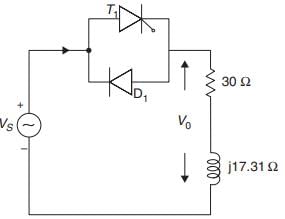Test: AC Voltage Controllers - Electrical Engineering (EE) MCQ
30 Questions MCQ Test - Test: AC Voltage Controllers
The below figure shows a single-phase voltage controller circuit.

The output voltage V0 is uncontrollable for firing angle ranging between

The output voltage V0 is uncontrollable for firing angle ranging between
Earlier then the semiconductor technology, ___________ devices were used for voltage control applications.
The AC voltage controllers are used in __________ applications.
The triac circuit shown in figure controls the AC output power to the resistive load. The peak power dissipation in the load is

A single-phase half wave voltage controller consists of
The torque produced by a single-phase induction motor fed by an ac voltage controller for speed control due to
The SCR T1 is fired at an angle of α, and the supply Vs = Vm sinωt. Find the average value of the output voltage.
The below given output voltage waveform can be obtained by a
In the below shown AC converter circuit with firing angle = α for both the devices, T2 will conduct from
The below given output voltage waveform can be obtained by a
In the integral cycle control method of ac voltage controller
In the integral cycle control of ac voltage controller, is the load is on for n cycles and off for m cycles, then the periodicity is given by? Consider the output is sinusoidal.
If k is the duty cycles of the controller, then the rms value of the output voltage in case of a integral cycle control circuit will be?
Consider the input to be sinusoidal with peak value Vm and rms value Vs.
Find the power delivered to the load in the integral cycle control method of ac voltage control, having a sine input of Vs, R load and duty cycle = k.
In the integral cycle control method with duty cycle = k and maximum load current = Im. Find the value of average SCR current.
The below given circuit has Vs = 230V and R = 20 Ω. Find the value of the average output voltage at the R load for a firing angle of 45°.
The below given circuit has Vs = 230V and R = 20 Ω. Find the value of the average output load current at the R load for a firing angle of 45°.
A single phase voltage controller has input of 230 V and a load of 15 Ω resistive. For 6 cycles on and 4 cycles off, determine the rms output voltage.
A single phase voltage controller has input of 230 V and a load of 15 Ω resistive. For 6 cycles on and 4 cycles off, determine the input pf.
A single phase voltage controller has input of 230 V and a load of 15 Ω resistive. For 6 cycles on and 4 cycles off, determine the power delivered to the load.
A single phase voltage controller has input of 230 V and a load of 15 Ω resistive. For 6 cycles on and 4 cycles off, determine the average value of SCR current.
A single-phase voltage controller, using one SCR in anti parallel with a diode, feeds a load R and Vs = 230 V. For a firing angel of 90° for the SCR, the PMMC voltage connected across R would read

















